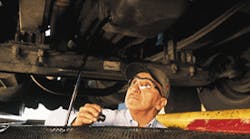Higher-than-expected levels of nitric acid formation could make extended drain intervals tougher to achieve with 2007 diesel truck engine oils—soon to be officially designated API CJ-4—according to Shell Lubricants.
The higher concentration of nitric acid is a side effect of the higher level of exhaust gas recirculation in ’07 engines, which causes greater amounts of nitrogen oxide (NOx) in the exhaust, higher head loads produced by the engines and more water condensation, according to Dan Arcy, technical product marketing manager for Shell Lubricants.
“The nitrogen is reacting with the water vapor and combustion heat,” he explained to FleetOwner. “And since the ’07 engines are using more EGR – almost double the amount of ’04 engines – more nitrogen will be present.”
But the ’07 oils should be able to maintain standard drain intervals, Arcy stressed. Formulation restrictions on ash levels have limited CJ-4 oils to a total base number (TBN) of between eight or nine, whereas previous oils might have TBNs as high as 11 or 12. Higher TBN can correspond to greater longevity.
Originally, Arcy said, lubricant makers figured that by removing sulfur from diesel fuel, moving from fuel with a sulfur content of 500 parts per million (PPM) to 15 PPM ultra low sulfur fuel (ULSD), CJ-4 oils could in some cases meet extended drain intervals as less sulfur translates into lower formations of sulfuric acid.
“We figured that reduction in sulfur could give us the feasibility to meet extended drains,” Arcy said. “Yet, in our testing, we saw significant increases in nitric acid. Even with more oil filtration, we can’t counteract that, because while better filtration removes particles and other crud from the oil, it can’t remove acid.”
Arcy added that Shell is testing its CJ-4 oils in a variety of different ’07 engines running on ULSD with customers, including some putting 5,000 miles a week on their tractors. To date, several of Shell’s test trucks have logged between 120,000 and 130,000 total miles, with one fleet test vehicle exceeding 150,000 miles. Overall, said Arcy, the oil is performing very well in terms of providing engine protection.
“We’ll know more in a few months, but right now, [CJ-4] is very much performing to expectations,” he said. “The only surprise is the nitric acid levels we’ve seen. In pre-’07 engines, there are no issues – it’s backward compatible and works well. Due to its new formulation, our CJ-4 blend provides better soot handling, wear protection, and oxidation control than our CI-4 Plus blend. So it’s a step up in many ways in terms of protecting engines.”
A price point has not been revealed for Shell CJ-4 oil. That will hinge on the lubricant maker’s decision on whether to continue offering their current CI-4 offerings as well as R&D considerations.
“We still haven’t made a commitment on pricing because there’s a lot involved,” said Arcy. “First, it’s definitely going to be more costly simply due to all the antioxidants we’re using in the oil – those are the most expensive components,” he explained. “Second, we’re doing a lot more testing and that requires us to burn a lot more fuel, which isn’t cheap. Caterpillar’s C-13 test alone is 500 hours long. Overall, it’s going to cost us about twice as much to qualify CJ-4 oil as compared to our previous CI-4 blends. Third, there’s a question as to whether customers will want to use two oils or switch to just one. That decision – whether to stock one or two products – affects the pricing issue as well.”




